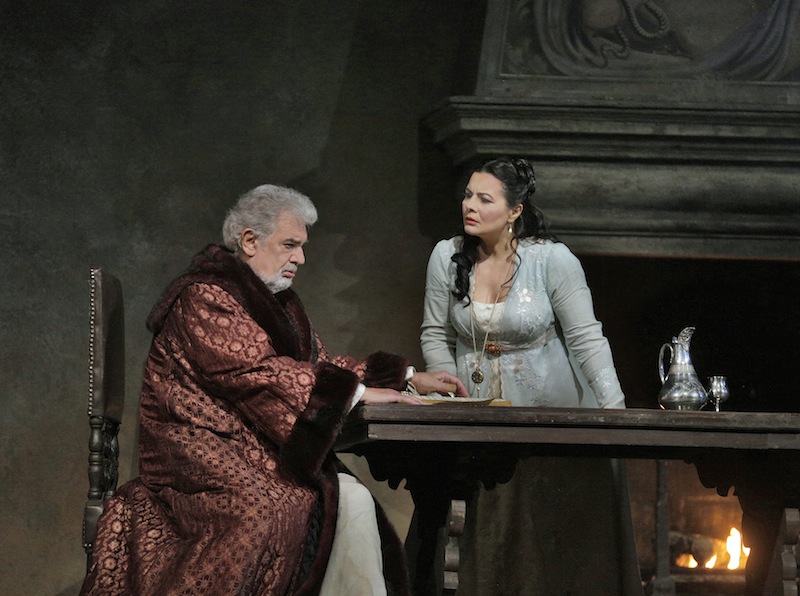Domingo and Levine bring rich, visceral advocacy to Met’s “Boccanegra”
Verdi’s Simon Boccanegra likely made the most sense to its original audiences in 19th century Italy. Francesco Maria Piave’s libretto (later revised by Arrigo Boito), is an ungainly and barely homogenized mix of history, political propaganda, romance, melodrama, conspiracy, and revenge. The politics, which touch on revolution and feature Petrach’s call for Italian unity, would have appealed to the Risorgimento movement (of which Verdi was a part), and the prominent question of sexual purity was pointed directly at the social values of the time.
While all the details make sense, put together they make for a plot that tips back and forth across a line of coherence, one that can be a challenge for contemporary audiences to sympathize with. There is also a notable variance in quality between the original 1857 score, and the Act I scene in the Doge’s council chambers that Boito added.
That is where a performance like the magnificent one that opened the Metropolitan Opera run Friday night, makes all the difference. When Simon Boccanegra is sung and played with such musicality, intensity, and expressive urgency, everything that the opera has to say hits with visceral meaning.
James Levine’s career seemed to sadly be approaching an end until new medication brought his Parkinson’s under control. The conductor was greeted with a huge ovation before the first note, and commenced to lead a richly assured performance, marked by beautiful phrasing, fine delineation of dynamics, and an accumulating dramatic weight. He shaped the chorus, which sang beautifully, like part of the instrumental ensemble, and the sound was gorgeous. The sole technical problems—moments when orchestra and singers debated tempo and the placement of the downbeat—were the commonplace stuff of most opera performances.
In his current baritone guise, Plácido Domingo’s voice is well past its prime, and his articulation was often mushy in the title role, but his artistry more than compensated. The color of his voice is dark but clear, and he sang at first with a brittle edge that later melted as he grew warmer. His breath support and stamina are secure, and rather than relying on a purely beautiful sound, he modulated his timbre and phrasing to capture the character’s interior thoughts and feelings. This was superb vocal acting and complex and mercurial music like “Nell’ora soave” and “Plebe! Patrizi! Popolo!” spilled out of him.
The performances around Domingo were excellent. Boccanegra is, for much of the opera, surrounded by enemies, and the most impressive and implacable one was bass Ferruccio Furlanetto, who played Fiesco, whose daughter, Maria, bore Boccanegra’s illegitimate daughter, also named Maria (but known as Amelia). Furlanetto sang with a gravity that expressed the character’s anger and sorrow, and despite the enormous size of his voice, his phrasing was creamy and subtle.
Baritone Brian Mulligan sang the duplicitous Paolo, driven to revenge when Boccanegra forbids him marrying Amelia. This is the most difficult role in the opera, superficial and one-dimensional, but Mulligan, through his voice, gave Paolo a burning fervor and bracing, nasty edge of spite and fear.
Joseph Calleja sang Adorno, who also loves Amelia, and his warm, slightly grainy tenor was an effectively disparate contrast with Domingo. His singing was marvelous throughout, with ease and elegance even in the murderous expression of “Sento avvampar nell’anima.”
A star of the evening was soprano Lianna Haroutounian, as Amelia. The character has some of the most impressive music in the opera, starting with her Act I aria “Come in quest’ora” and continuing through a series of duets and trios with Adorno and Boccanegra.
Haroutounian began with a simple and attractive luminosity and then, throughout the performance, added increasing levels of musical and emotional depth—she guided the dramatic direction of the performance as much as Domingo. Her high notes, sung with as rich, rounded, and clear tone as everything else, were prominent, but the way she shaped her lines, building to the climaxes, was scintillating.
Simon Boccanegra is an opera full of ensembles, small and large, and all these wonderful parts came together in a tremendous whole. The tension between Boccanegra and Fiesco grew and transformed throughout the evening, and the trio of Boccanegra, Amelia, and Adorno at the end of Act II, the characters revealing secrets and reconciling enmities, was ravishing.
Michael Scott’s production is traditional period style, a sensible way to present the story, and though it is now over twenty years old, the exquisitely crafted sets and costumes mix evocatively with the music and with the vital performances.
Simon Boccanegra runs through April 16 metopera.org



